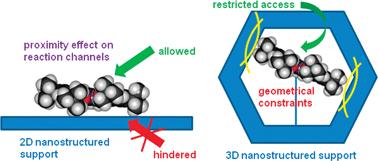Enantioselective catalysis with chiral complexes immobilized on nanostructured supports†
Abstract
In this tutorial review, we discuss how recycling and stability advantages alone are frequently not sufficient to justify the effort necessary to immobilize chiral complexes unless additional advantages are found. Nanostructured solids with well-controlled surfaces and pores may act as nanoreactors, hindering or even blocking some of the reaction channels, and hence modifying the stereochemical result of the reaction. The use of support effects to improve or change the enantioselectivity is emerging as an interesting field, whose understanding might allow, in the near future, the design of chiral

- This article is part of the themed collection: Nanoscale Chirality

 Please wait while we load your content...
Please wait while we load your content...